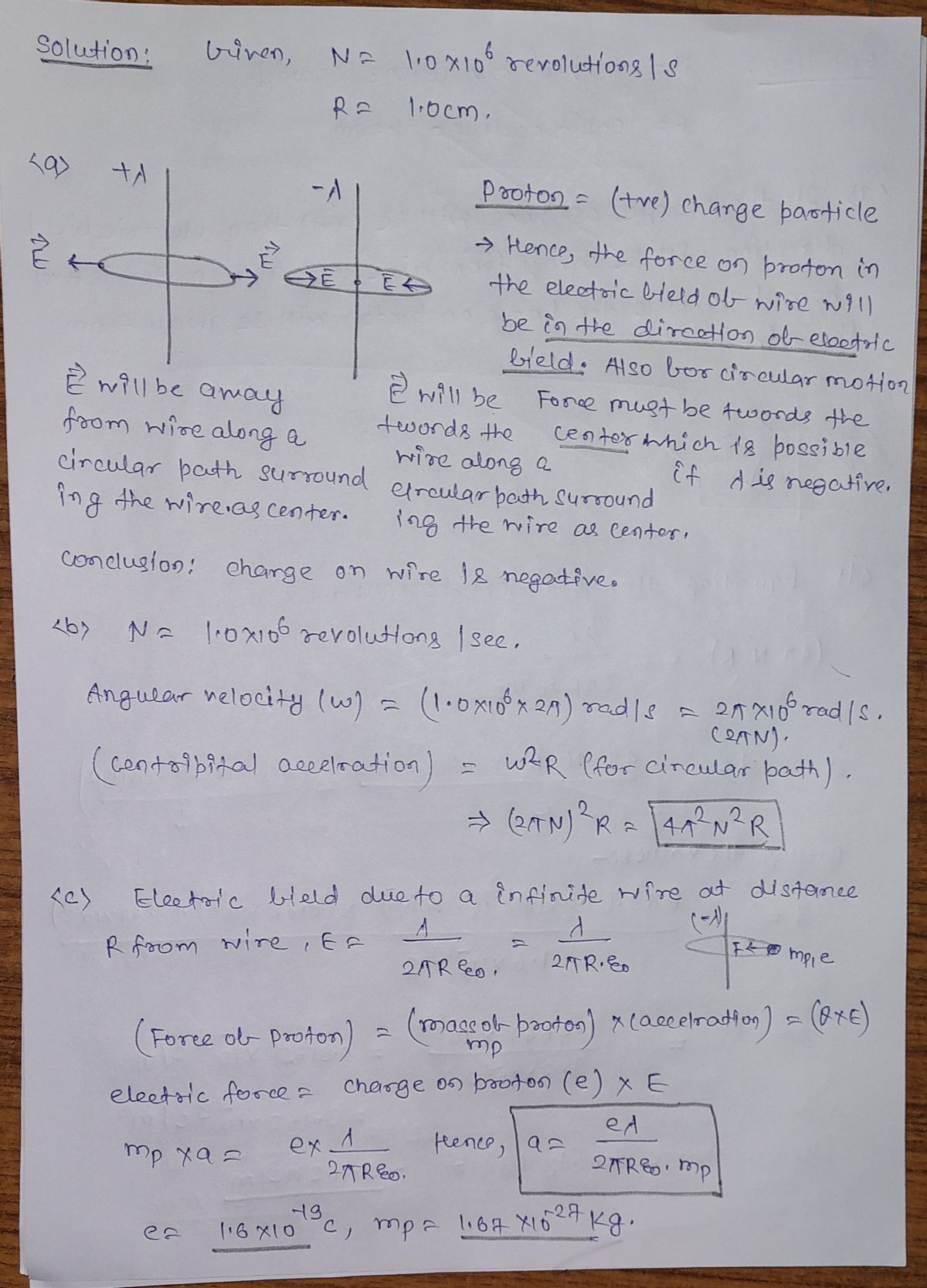Problem 2: A proton orbits a long charged wire, making N = 1.0×10° revolutions per second. The radius of the orbit is R = 1.0 cm (see Fig.2). What is the wire's linear charge density?
Problem 2: A proton orbits a long charged wire, making N = 1.0×10° revolutions per second. The radius of the orbit is R = 1.0 cm (see Fig.2). What is the wire's linear charge density?
College Physics
11th Edition
ISBN:9781305952300
Author:Raymond A. Serway, Chris Vuille
Publisher:Raymond A. Serway, Chris Vuille
Chapter1: Units, Trigonometry. And Vectors
Section: Chapter Questions
Problem 1CQ: Estimate the order of magnitude of the length, in meters, of each of the following; (a) a mouse, (b)...
Related questions
Question
I need help with A,B,C,D and E and there is any chance that you can label which one is which thank you
![Problem 2: A proton orbits a long charged wire, making N = 1.0 x 106 revolutions
per second. The radius of the orbit is R = 1.0 cm (see Fig.2). What is the wire's linear
charge density?
a) For such motion to be possible, should the charge on the wire be positive or
negative? In Fig.2, draw the electric field created by the wire.
b) Express the centripetal acceleration of the proton in terms of its orbital pa-
rameters R and N.
J²
R
mp, e
FIG. 2: The scheme for
Problem 2
c) Express the acceleration of the proton in terms of the electric field acting on it. You need to use the
formula for the field of an infinite charged wire.
3
d) Equating the two expressions for the proton's acceleration, deduce the absolute value of the linear
charge density on the wire, [2].](/v2/_next/image?url=https%3A%2F%2Fcontent.bartleby.com%2Fqna-images%2Fquestion%2F03ab7fd8-d2de-43d5-8ef6-d441993b6519%2Fb8231063-d3b6-44a3-b317-ea955a941e9c%2Fvn4fl3_processed.png&w=3840&q=75)
Transcribed Image Text:Problem 2: A proton orbits a long charged wire, making N = 1.0 x 106 revolutions
per second. The radius of the orbit is R = 1.0 cm (see Fig.2). What is the wire's linear
charge density?
a) For such motion to be possible, should the charge on the wire be positive or
negative? In Fig.2, draw the electric field created by the wire.
b) Express the centripetal acceleration of the proton in terms of its orbital pa-
rameters R and N.
J²
R
mp, e
FIG. 2: The scheme for
Problem 2
c) Express the acceleration of the proton in terms of the electric field acting on it. You need to use the
formula for the field of an infinite charged wire.
3
d) Equating the two expressions for the proton's acceleration, deduce the absolute value of the linear
charge density on the wire, [2].
Expert Solution
Step 1

Step by step
Solved in 2 steps with 2 images

Knowledge Booster
Learn more about
Need a deep-dive on the concept behind this application? Look no further. Learn more about this topic, physics and related others by exploring similar questions and additional content below.Recommended textbooks for you

College Physics
Physics
ISBN:
9781305952300
Author:
Raymond A. Serway, Chris Vuille
Publisher:
Cengage Learning

University Physics (14th Edition)
Physics
ISBN:
9780133969290
Author:
Hugh D. Young, Roger A. Freedman
Publisher:
PEARSON

Introduction To Quantum Mechanics
Physics
ISBN:
9781107189638
Author:
Griffiths, David J., Schroeter, Darrell F.
Publisher:
Cambridge University Press

College Physics
Physics
ISBN:
9781305952300
Author:
Raymond A. Serway, Chris Vuille
Publisher:
Cengage Learning

University Physics (14th Edition)
Physics
ISBN:
9780133969290
Author:
Hugh D. Young, Roger A. Freedman
Publisher:
PEARSON

Introduction To Quantum Mechanics
Physics
ISBN:
9781107189638
Author:
Griffiths, David J., Schroeter, Darrell F.
Publisher:
Cambridge University Press

Physics for Scientists and Engineers
Physics
ISBN:
9781337553278
Author:
Raymond A. Serway, John W. Jewett
Publisher:
Cengage Learning

Lecture- Tutorials for Introductory Astronomy
Physics
ISBN:
9780321820464
Author:
Edward E. Prather, Tim P. Slater, Jeff P. Adams, Gina Brissenden
Publisher:
Addison-Wesley

College Physics: A Strategic Approach (4th Editio…
Physics
ISBN:
9780134609034
Author:
Randall D. Knight (Professor Emeritus), Brian Jones, Stuart Field
Publisher:
PEARSON